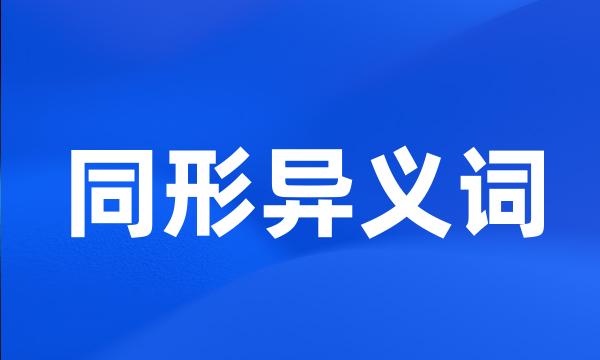同形异义词
- 名homograph;homonym
 同形异义词
同形异义词-
同形异义词的出现恰好体现了二者之间的矛盾与竞争。
The appearance of the homograph just reflect the confliction and the competition between these two motivations .
-
小议苏州话与普通话的同形异义词
On Homograph between Suzhou Dialect and Putonghua
-
其中有许多同形异义词,查检使用时须加分辨。
There are many homonyms , so you have to distinguish .
-
第四章为汉韩同形异义词比较分析。
The fourth chapter is the homographs comparative analysis .
-
英语同形异义词的动因分析
The motivation analysis of the homonym in English
-
本词典在同形异义词的右上角标注数字以资区别
Different word with the same spelling be distinguished in this dictionary by superscript numbers
-
本文从同形异义词词义的释义、词汇教学方法、以及词汇的练习几个方面分析同形异义词的教学。
This part discusses in homographs meaning explaining method , homographs teaching method and homographs practice .
-
《广韵》之后,因语言文字的发展演变,又产生了许多同形异义词。
Due to the development of Chinese characters , more homonyms were coined after Guang Yun .
-
拼写相同意思不同的两个单词是同形异义词。
Two words are homographs if they are spelled the same way but differ in meaning .
-
实际上,广告中的双关语有很多形式,并没有统一的分类标准。有些人把双关语分为同音异形词、同音同形异义词、同形异义词。
In fact , a pun takes several forms in advertisements and there is no unified standard for the classification .
-
同形异义词两个或以上单词拼法相同,但在起源、意义和有时读音上不同。
One of two or more words that have the same spelling but differ in origin , meaning , and sometimes pronunciation .
-
本文的研究主要分三个部分:第一部分为韩语与汉语中的同形异义词对比分析,包括其形成的原因,及韩语与汉语中同形异义词词义的对比分析。
This paper contains three parts . The first part is the homographs comparing in Chinese and Korean and the cause reason analysis of homographs .
-
韩国语中存在大量汉字词,尤其是同形异义词的存在使韩国学生在学习和使用汉语的过程中常常会发生错误和偏误。
There are a lot of Chinese-character-words in Korean language , especially homographs , which often cause mistakes and errors when South Korean students learn and use Chinese .
-
试论英语多义词与同形异义词的识别和名词或代词名词短语结合形成前置词短语同其他单词有形容词或副词的关系。
A function word that combines with a noun or pronoun or noun phrase to form a prepositional phrase that can have an adverbial or adjectival relation to some other word .
-
然而大部分的传统研究都局限于多义词内部成分上,例如如何区分一词多义和同形异义词。
But many traditional researches are confined to the inner elements of polysemous word , for instance , the difference between polysemy and homonymy . They missed the whole picture of polysemy for ignoring the external elements of polysemy .
-
同义词,反义词,同形同音异义词专业词典。
Scholastic Dictionary of Synonyms , Antonyms , and Homonyms .
-
本文较系统解释了形式语言学,以及其理论观点不能区分多义词与同形同音异义词。
This chapter gives a systematic account of the formal school , but the viewpoint can not explain the difference between polysemy and homonymy .
-
同形异义汉字词作为同形词的一部分,在它自身的形成与发展、演变过程中,受到历史、社会等客观因素的影响,还受到语言系统内部的影响。
As a part of homonymy , Homonym Chinese characters were affected by both objective and subjective factors ( historical , social and other objective factors , and the internal language system ) during their formation , development , and the evolution processes .
-
传统图书馆所使用的受控词表采用自上而下的组织方式,强制要求使用预先确定且经过权威认定的术语,能够解决有关同形异义字、同义词和多义词的问题,在信息组织方面具有广泛应用。
Traditional controlled vocabulary , which has a wide application in the information management field , has adopt a top-down organizational method and pre-determined terms , can solve the homonymy , synonyms polysemous and so on .
-
根据汉字词的特点,汉字词一共可以分为三大类。即同形同义词,同形异义词,异性同义词。
According to the characteristics of the Chinese characters words , Chinese characters word altogether can be divided into three categories as same type synonyms , homonyms , heterosexual synonyms .
-
同形同义词主要通过发音,同形异义词主要通过词汇含义对比,异性同义词主要通过标记的方法来进行词汇教育。
The same shape synonyms primarily through the pronunciation , homographs mainly through word meaning contrast , heterosexual synonyms by labeling approach to lexical education .
-
第三章从词义的角度出发,将同形词分为同形同义词和同形异义词。
In the third chapter , identical words have been divided into synonymy and homograph from semanteme .
-
汉语和日语里存在着大量的汉日同形词,根据词义一般可以划分为同形同义词、同形异义词、同形近义词三类。
As is known to us , there are numbers of homographs in Chinese and Japanese languages , and these words can be , based on their meanings , classified into isomorphic synonyms , homonyms and isomorphic near synonyms .
-
并将汉韩同形词分为两类:1、同形同义词2、同形异义词。
They can be divided into two categories : synonymy and homograph .
-
汉日同形词出现偏误的比例由大到小依次为:同形近义词、同形同义词、同形异义词。
Chinese , word of the errors with form appeared to small scale by big is in the shape near synonyms , with shape with synonyms , homonymy word .
-
在三类汉日同形词偏误句中,同形近义词偏误占偏误总量比例最大;其次是同形同义词偏误;而同形异义词偏误所占比例最小。
In the three types of Chinese-Japanese homographs , the error of the isomorph synonyms takes the largest proportion in the total errors , the second part is the error of synonyms with same form , and the least one is the homographs .
